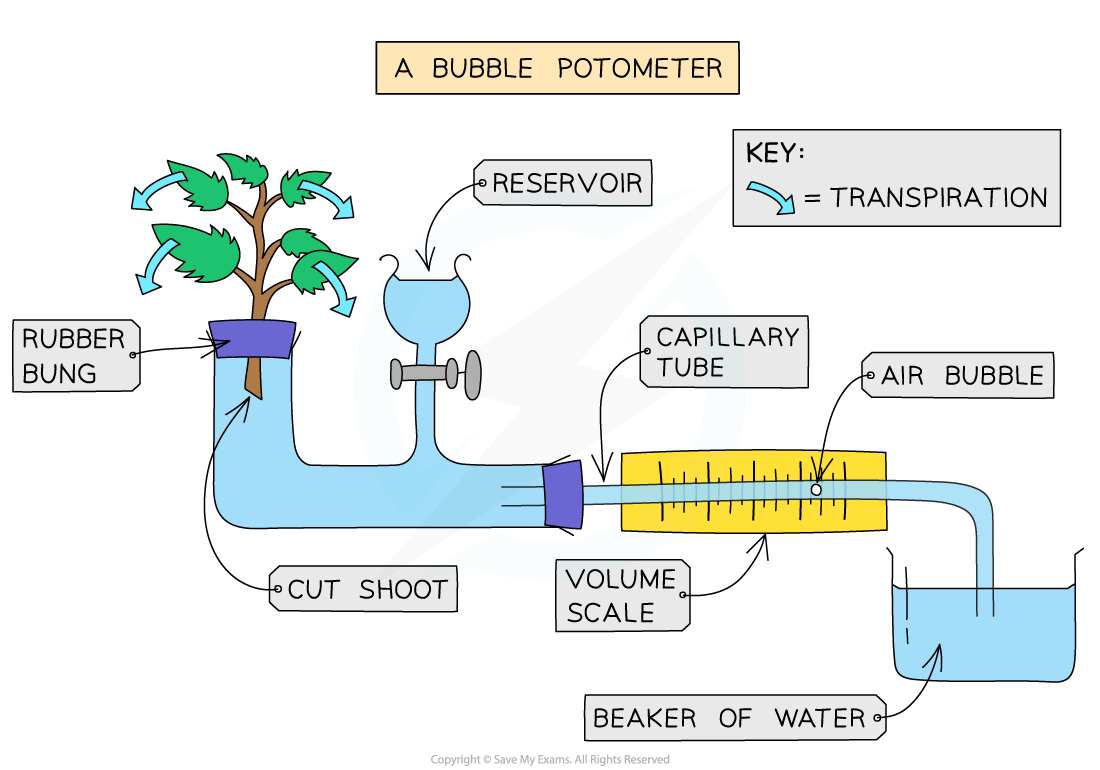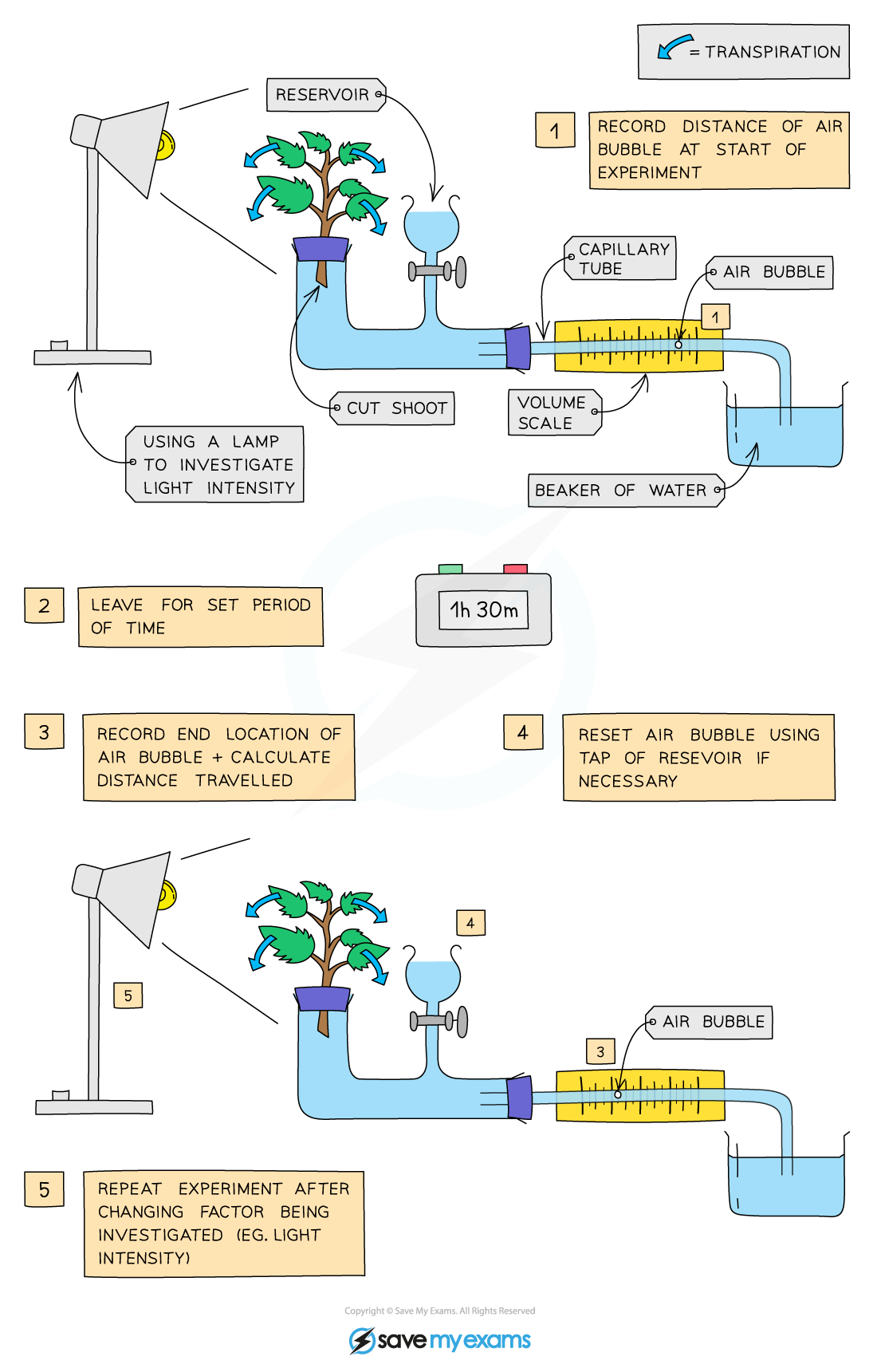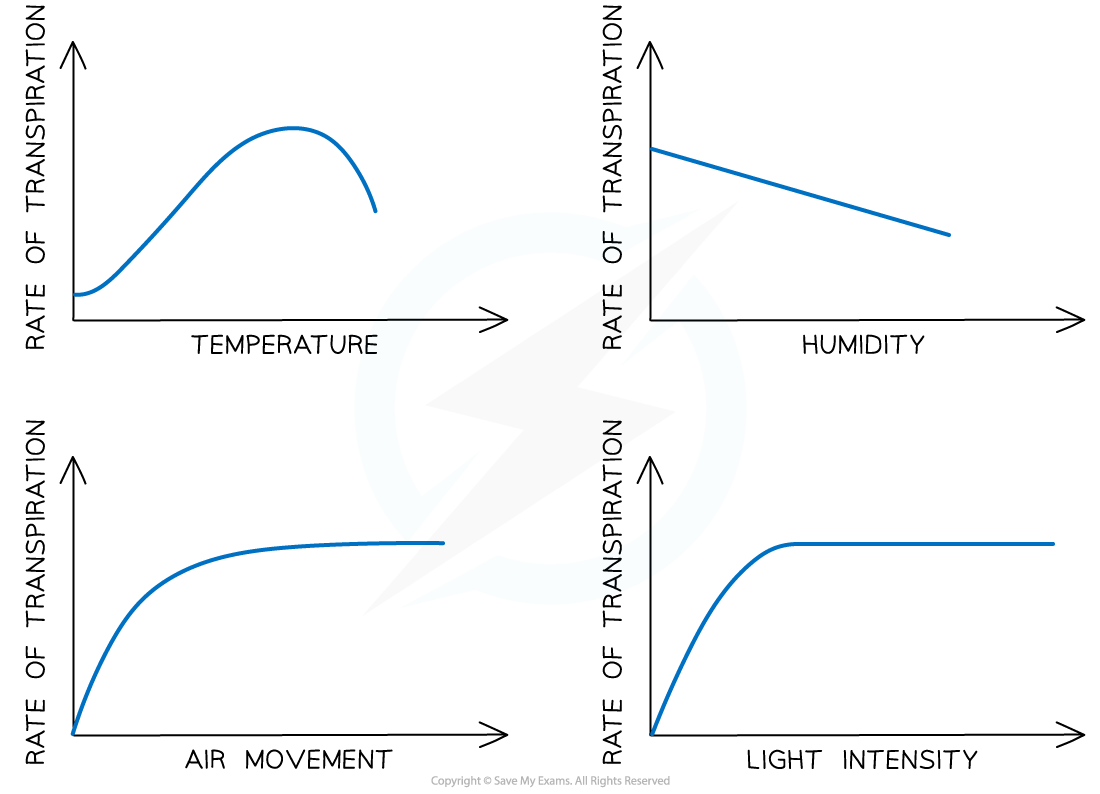Practical 7: Potometers & the Rate of Transpiration
- The effect of environmental factors on the rate of transpiration in plants can be measured using a piece of equipment called a potometer
- Note that while potometers are used to measure transpiration rates, they technically measure the rate of water uptake rather than the rate of transpiration, as a small amount of the water taken up by a plant will be used in photosynthesis
- Because the amount of water used in photosynthesis is so small in relation to the total amount of water that passes through a plant, the rate of water uptake can reasonably be used to represent the rate of transpiration
- Note that while potometers are used to measure transpiration rates, they technically measure the rate of water uptake rather than the rate of transpiration, as a small amount of the water taken up by a plant will be used in photosynthesis
- Different types of potometer exist
- Bubble potometers measure the movement of an air bubble along a water-filled tube connected to a plant shoot as water is drawn up by the shoot
- The position of the air bubble is recorded at the start of an experiment, and then a researcher can either measure how far the bubble moves in a set amount of time, or time how long it takes for the bubble to move a certain distance
- Mass potometers measure the change in mass of a water-filled test tube connected to a plant shoot as it loses water over a set amount of time
- Bubble potometers measure the movement of an air bubble along a water-filled tube connected to a plant shoot as water is drawn up by the shoot
- The effect of various environmental factors on transpiration can be measured by placing the potometer in different conditions e.g.
- Wind speed
- Humidity
- Light intensity
- Temperature
 A bubble potometer uses the movement of an air bubble to measure the rate at which water is drawn up by a plant shoot. In this image the air bubble will move to the left along the tube as the plant transpires.
A bubble potometer uses the movement of an air bubble to measure the rate at which water is drawn up by a plant shoot. In this image the air bubble will move to the left along the tube as the plant transpires.Investigating the effect of light intensity on the rate of transpiration
Apparatus
- Plant shoot
- Cutting board
- Scalpel/scissors
- Paper towels
- Potometer
- Volume scale
- Beaker
- Capillary tube
- Stopwatch
- Vaseline
Method
- Cut a shoot underwater
- This is done to prevent air from entering the xylem; this could block the movement of water through the plant
- Set up the apparatus as shown in the diagram, ensuring that it is airtight, and using vaseline to seal any possible gaps
- Dry the leaves of the shoot
- Any water present on the leaves might affect the rate of transpiration as it could block the stomata
- Remove the capillary tube from the beaker of water to allow a single air bubble to form and then place the tube back into the water
- Set up a light source from which the light intensity can be varied
- This could be achieved by varying the light bulbs used or by varying the distance between the light source and the plant shoot
- Allow the plant to adapt to the new environment for 5 minutes
- Record the starting location of the air bubble, leave for a set period of time, and then record the end location of the air bubble
- Change the light intensity by a measurable amount e.g. moving the lamp 10cm further away from the plant shoot
- Reset the bubble by opening the tap below the reservoir
- Repeat the experiment at the new light intensity, and again at a range of different intensities
 The effect of light intensity on rate of transpiration can be measured using a potometer
The effect of light intensity on rate of transpiration can be measured using a potometerThe Effect of Temperature & Humidity on Transpiration Rates
- A potometer can be used to test hypotheses about the effect of various environmental factors, including temperature or humidity, on transpiration rates
- Environmental factors can be investigated in the following ways
- Air movement
- A fan on different settings could be used to vary the flow of air around a plant shoot
- Humidity
- Enclosing the plant shoot in a plastic bag can increase the humidity
- A humidifier or dehumidifier could be used to give a measurable variation in humidiy
- Light intensity
- A lamp at different distances or with different types of light bulb can be used to vary light intensity
- Temperature
- A thermometer or temperature probe can be used to find surroundings with different air temperatures
- A heater or air conditioner can be used to give a measurable variation in temperature
- Air movement
- A researcher would need to be aware of the importance of controlling any variables other than the variable of interest to ensure that any results were valid e.g. placing a plant shoot in different rooms could be a way of varying temperature, but might bring the risk of also varying light levels and humidity; these variables would need to be controlled
Factors affecting the rate of transpiration
- Air movement
- More air movement leads to increased rates of transpiration
- The air outside a leaf usually contains a lower concentration of water vapour than the air spaces inside a leaf, causing water vapour to diffuse out of the leaf
- When the air is relatively still, water molecules can accumulate just outside the stomata, creating a local area of high humidity
- Less water vapour will diffuse out into the air due to the reduced concentration gradient
- Air currents, or wind, can carry water molecules away from the leaf surface, increasing the concentration gradient and causing more water vapour to diffuse out
- More air movement leads to increased rates of transpiration
- Temperature
- Higher temperatures lead to higher rates of transpiration, up to a point at which transpiration rates will slow
- An increase in temperature results in an increase in the kinetic energy of molecules
- This increases the rate of transpiration as water molecules evaporate out of the leaf at a faster rate
- If the temperature gets too high the stomata close to prevent excess water loss
- This dramatically reduces the rate of transpiration
- Higher temperatures lead to higher rates of transpiration, up to a point at which transpiration rates will slow
- Light intensity
- Higher light intensities will increase the rate of transpiration up to a point at which transpiration rates will level off
- Stomata close in the dark and their closure greatly reduces the rate of transpiration
- Stomata open when it is light to enable gas exchange for photosynthesis; this increases the rate of transpiration
- Once the stomata are all open any increase in light intensity has no effect on the rate of transpiration
- Higher light intensities will increase the rate of transpiration up to a point at which transpiration rates will level off
- Humidity
- Higher humidity levels reduce the rate of transpiration
- If the humidity is high that means the air surrounding the leaf surface is saturated with water vapour
- This causes the rate of transpiration to decrease as there is no concentration gradient between the inside of the leaf and the outside
- At a certain level of humidity, an equilibrium is reached; water vapour levels inside and outside the leaf are the same, so there is no net loss of water vapour from the leaves
- Higher humidity levels reduce the rate of transpiration
 Several environmental factors affect the rate of transpiration in plants
Several environmental factors affect the rate of transpiration in plantsExam Tip
Remember when designing an investigation that you must keep all factors the same other than the one you are investigating. This ensures that you measure the variable that you set out to measure and not the impact of any other variable.
